An eventful Sunday at South Pole
Temperature: minus 32 Celsius, minus 25.6 F
Windchill: Minus 47.1 C, minus 52.9 F
Wind: 13 knots
Friday night was an "all-nighter” to post journals and prepare for the "Life From IPY” broadcast. Staying up is not so hard to do since the sun is always up. However, it is advised to get enough sleep in these harsh conditions at high altitude. I went to bed at 7 am and got up at noon. Saturday was too windy for another balloon experiment. So I finished preparing my part for the science lecture on Sunday.
All kinds of activities are planned throughout the week for recreation, in particular on the weekend. The dining hall is designed to be used for lectures and general movie presentations. This Saturday night 8mp we all could see the documentary about the construction of the new station called "Man Made”, produced by National Geographic. I was amazed how many people worked hard under such extreme conditions.
The new South Pole station
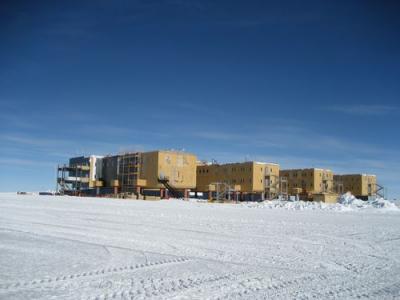
Sundays is a non-working day for most people at the station, except for scientists. A cold breakfast is served in the early morning but instead of lunch, an elaborate brunch is served at 10 am. My team and I gathered for brunch and planned the day with another balloon experiment for surface ozone detection. Since we had stronger winds, we planned to drive out the balloon to the end of the runway so it will fly over the station and hopefully land near our Balloon Inflation Facility (BIF) and not land so far out as on Friday.
We prepared the balloon as usually in the BIF. Patrick will leave on Monday, so we all were carefully observing all of his steps while preparing the balloon with attachments. I took notes and Bryan filmed him. He and Andy are very efficient and they work very fast. This must be a family trait since Andy is Patrick's uncle!
Patrick is attaching the "cutting device" to the parachute and Andy is checking the weight.
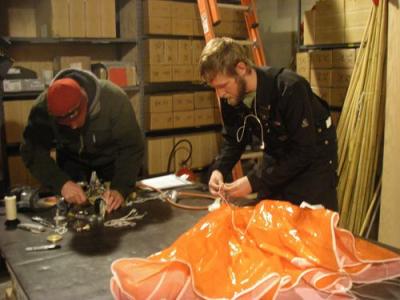
Answer to yesterday’s question: "how do we determine that the ozone sonde will be released at a certain altitude?”
The "cutting device” is set to send electricity to two metal pins at a certain altitude: at 600 millibar. The now heated metal pin will burn through the thread, releasing the balloon. The Ozone sonde will descent via parachute to the ground.
This is the "cutting device”
<img class="standalone-image" src="/files/resize/members/elke-bergholz/images/1207burndevi-400x300.jpg" width="400" height="300" />
A radio sonde is submitting the data back to the ground to a computer
Bryan is adding a battery to the radio sonde.
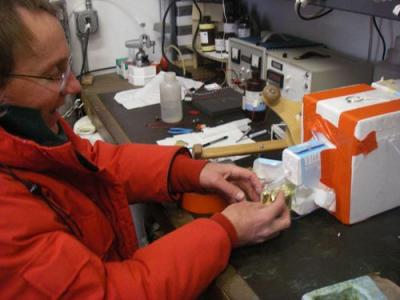
In the top part of the box is a GPS attached (black device) , In the middle is the ozone sonde, the lower part is the radio sonde.
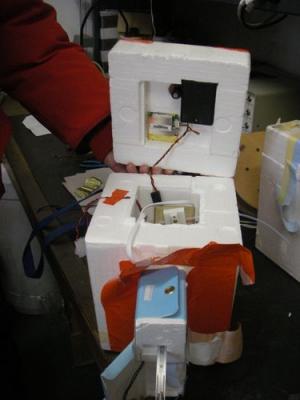
As usually, the ozone sonde needs to be conditioned outside for 10 minutes so it can give an accurate ground ozone reading.
I am holding the container that contains the GPS, the radio sonde , and the ozone sonde.
<img class="standalone-image" src="/files/resize/members/elke-bergholz/images/120907elksonout-400x300.jpg" width="400" height="300" />
The ozone sonde is outside for 10 minutes. In the background one can see the dome, of the previous station at the South Pole.
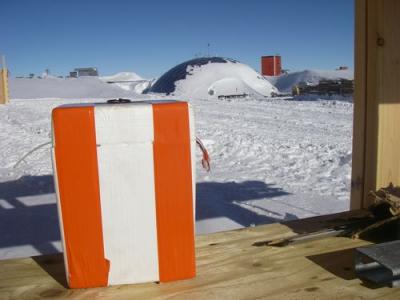
Andy and Patrick are driving the balloon and the ozone sonde to the end of the run way. No planes were scheduled for today, Sunday. So the communication department gave us the ok to use that area.
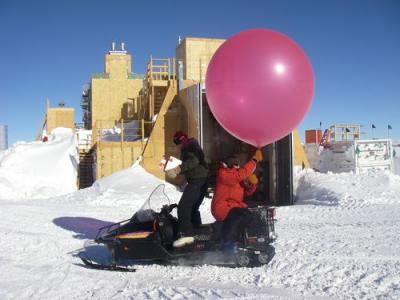
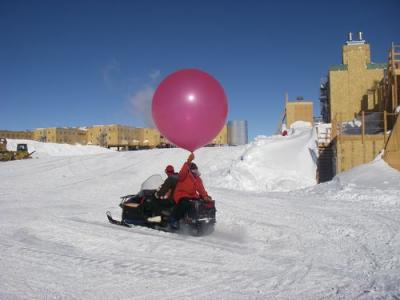
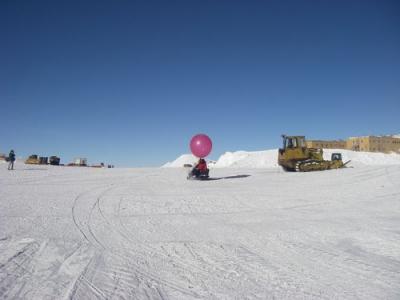
Unfortunately, The wind carried the ballon even further into the restricted seismology area, the "Quiet Zone”. We could not retrieve it but we have the data in the computer.
We went to ARO to finish up some work. I am carrying the PolarTREC computer to the observatory.
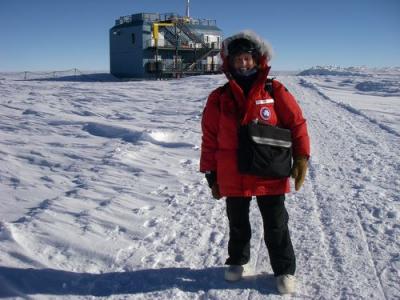
We also had tea time with some " German Stollen” mailed to me by my friend Jeannie Lythcott from Stanford University in California. The team truly enjoyed it. Thank you Jeannie!
These are Amy, Bryan and me having a break with " German Stollen” .
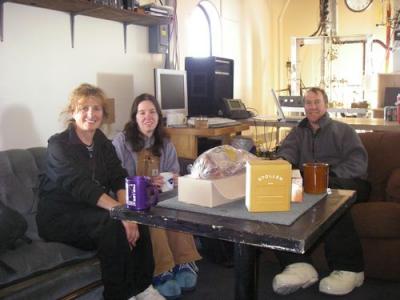
Patrick has to leave tomorrow and will truly be missed. It was great fun working with him. He will go to Greenland in the summer and work at the Summit Station. Next year he will stay over the winter time at the South Pole.
He has been excited about ice since he was very young. With 6 years he started figure skating and won the junior competition in the US several times. He also loves ice sculpturing and he feels sorry that he has to miss the South Pole ice sculpture competition at Xmas. So he made his own ice sculpture.
This is Patrick on his ice whale. The two stations, the old to the left and the new to the right are in the background.
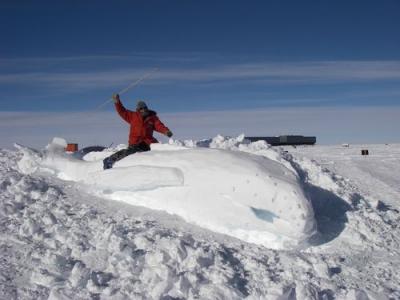
The Sunday science talk went well . The dining room was filled for the science lecture.
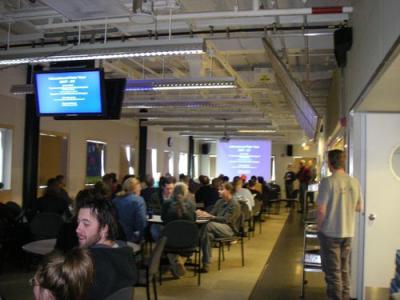
Both Bryan and I were grateful to NSF for the opportunity to present about the PolarTREC , the outreach program and the ozone project.
I am introducing our PolarTREC outreach program
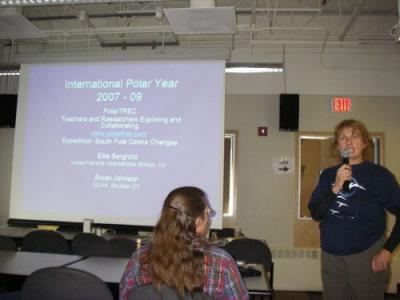
Bryan is discussing the ozone profile that allows to determine the ozone hole
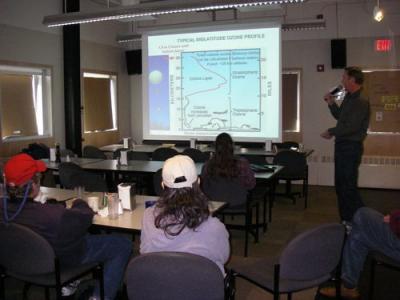
It was an eventful Sunday at South Pole station and tonight I am going to dream to be an "Ice Whale Rider”.
This is me riding ice whale!! Good night!
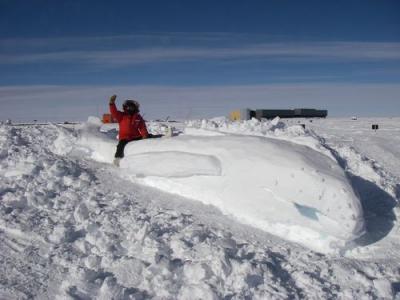
Question: What is the relationship between photo-chemistry and eleveted surface ozone?

